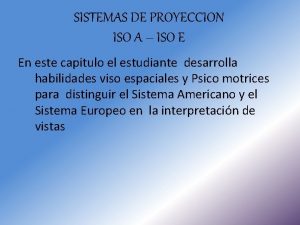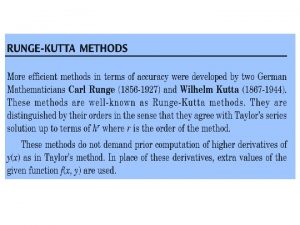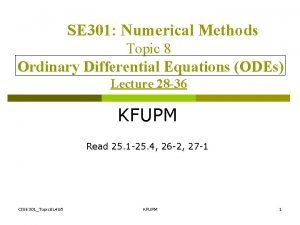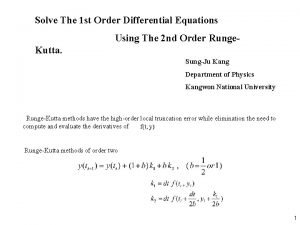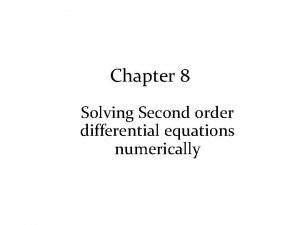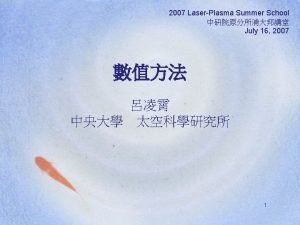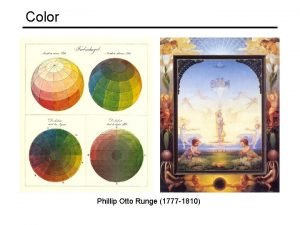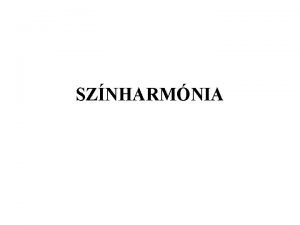Color Phillip Otto Runge 1777 1810 What is






















































- Slides: 54

Color Phillip Otto Runge (1777 -1810)

What is color? • Color is the result of interaction between physical light in the environment and our visual system • Color is a psychological property of our visual experiences when we look at objects and lights, not a physical property of those objects or lights (S. Palmer, Vision Science: Photons to Phenomenology)

Outline • • • Physical origin of color Spectra of sources and surfaces Physiology of color vision Trichromatic color theory Color spaces Color constancy, white balance

Electromagnetic spectrum Human Luminance Sensitivity Function

The Physics of Light Any source of light can be completely described physically by its spectrum: the amount of energy emitted (per time unit) at each wavelength 400 - 700 nm. Relative spectral power © Stephen E. Palmer, 2002

Spectra of Light Sources Rel. power Some examples of the spectra of light sources © Stephen E. Palmer, 2002

Spectra of light sources Source: Popular Mechanics

XKCD Christmas Lights https: //www. xkcd. com/1308/

Reflectance Spectra of Surfaces % Light Reflected Some examples of the reflectance spectra of surfaces Red Yellow Blue Purple 400 700 Wavelength (nm) © Stephen E. Palmer, 2002

Interaction of light and surfaces • Reflected color is the result of interaction of light source spectrum with surface reflectance

Interaction of light and surfaces • What is the observed color of any surface under monochromatic light? Olafur Eliasson, Room for one color

The Eye The human eye is a camera! • Lens - changes shape by using ciliary muscles (to focus on objects at different distances) • Pupil - the hole (aperture) whose size is controlled by the iris • Iris - colored annulus with radial muscles • Retina - photoreceptor cells Slide by Steve Seitz

Rods and cones, fovea pigment molecules Rods are responsible for intensity, cones for color perception Rods and cones are non-uniformly distributed on the retina • Fovea - Small region (1 or 2°) at the center of the visual field containing the highest density of cones – and no rods Slide by Steve Seitz

Rod / Cone sensitivity Why can’t we read in the dark? Slide by A. Efros

Physiology of Color Vision Three kinds of cones: • Ratio of L to M to S cones: approx. 10: 5: 1 • Almost no S cones in the center of the fovea © Stephen E. Palmer, 2002

Physiology of Color Vision: Fun facts • “M” and “L” pigments are encoded on the X-chromosome • That’s why men are more likely to be color blind • “L” gene has high variation, so some women may be tetrachromatic • Some animals have one (night animals), two (e. g. , dogs), four (fish, birds), five (pigeons, some reptiles/amphibians), or even 12 (mantis shrimp) types of cones http: //ngm. nationalgeographic. com/2016/02/evolution-of-eyes-text http: //en. wikipedia. org/wiki/Color_vision Slide by D. Hoiem

Color perception M L Power S Wavelength Rods and cones act as filters on the spectrum • To get the output of a filter, multiply its response curve by the spectrum, integrate over all wavelengths – Each cone yields one number • How can we represent an entire spectrum with three numbers? • We can’t! Most of the information is lost – As a result, two different spectra may appear indistinguishable » such spectra are known as metamers Slide by Steve Seitz

Metamers

Quantifying color • Spectral distributions go through a “black box” (human visual system) and are perceived as color • The only way to quantify the “black box” is to perform a human study Spectral distribution “Black box” Source: M. Brown

Color matching experiments • We would like to understand which spectra produce the same color sensation in people under similar viewing conditions Wandell, Foundations of Vision, 1995

Color matching experiment 1 Source: W. Freeman

Color matching experiment 1 p 2 p 3 Source: W. Freeman

Color matching experiment 1 p 2 p 3 Source: W. Freeman

Color matching experiment 1 The primary color amounts needed for a match p 1 p 2 p 3 Source: W. Freeman

Color matching experiment 2 Source: W. Freeman

Color matching experiment 2 p 1 p 2 p 3 Source: W. Freeman

Color matching experiment 2 p 1 p 2 p 3 Source: W. Freeman

Color matching experiment 2 We say a “negative” amount of p 2 was needed to make the match, because we added it to the test color’s side. p 1 p 2 p 3 The primary color amounts needed for a match: p 1 p 2 p 3 Source: W. Freeman

Trichromacy • In color matching experiments, most people can match any given light with three primaries • Primaries must be independent • For the same light and same primaries, most people select the same weights • Exception: color blindness • Trichromatic color theory • Three numbers seem to be sufficient for encoding color • Dates back to 18 th century (Thomas Young) https: //en. wikipedia. org/wiki/Young_Helmholtz_theory

Color matching is linear • Let’s fix primaries P 1, P 2, and P 3 and suppose that a test light A can be matched with primary weights a 1, a 2, and a 3 • Write A = (a 1, a 2, a 3) for short • Empirically, color matching obeys Grassman’s laws • If two test lights can be matched with the same set of weights, then they match each other: – If A = (a 1, a 2, a 3) and B = (a 1, a 2, a 3), then A = B • If we mix two test lights, then mixing the matches will match the result: – Suppose A = (a 1, a 2, a 3) and B = (b 1, b 2, b 3). Then A + B = (a 1 + b 1, a 2 + b 2, a 3 + b 3) • If we scale the test light, then the matches get scaled by the same amount: – Suppose A = (a 1, a 2, a 3). Then w A = (w a 1, w a 2, w a 3)

Color matching is linear • Let’s fix primaries P 1, P 2, and P 3 and suppose that a test light A can be matched with primary weights a 1, a 2, and a 3 • Write A = (a 1, a 2, a 3) for short • Empirically, color matching obeys Grassman’s laws • We can define a linear color space in which coordinates of a light are given by the weights of primaries needed to match it • The coordinates of a linear combination of lights are given by the linear combination of the respective coordinates – If A = (a 1, a 2, a 3) and B = (b 1, b 2, b 3), then u A + v B = (u a 1 + v b 1, u a 2 + v b 2, u a 3 + v b 3)

Finding coordinates in a linear space Find: weights of the primaries needed to match the target signal Given: a choice of three primaries and a target color signal ? p 1 p 2 p 3

Finding coordinates in a linear space • λ

Finding coordinates in a linear space •

Matching functions • Matching functions act as filters on the target spectrum, like response curves of color receptors!

Linear color spaces • Defined by a choice of three primaries • The coordinates of a color are given by the weights of the primaries used to match it • In addition to primaries, need to specify matching functions: the amount of each primary needed to match a monochromatic light source at each wavelength RGB matching functions RGB primaries

Comparison of RGB matching functions with best 3 x 3 transformation of cone responses Wandell, Foundations of Vision, 1995

Linear color spaces: CIE XYZ • Primaries are imaginary, but matching functions are everywhere positive • The Y parameter corresponds to brightness or luminance of a color • 2 D visualization: draw (x, y), where x = X/(X+Y+Z), y = Y/(X+Y+Z) Matching functions http: //en. wikipedia. org/wiki/CIE_1931_color_space

Linear color spaces: CIE XYZ • CIE XYZ is based on color matching experiments carried out in late 1920 s by W. David Wright (Imperial College) and John Guild (National Physical Laboratory, London) • The experiments used 17 “standard observers” (10 by Wright, 7 by Guild) Source: M. Brown

Uniform color spaces • Unfortunately, differences in x, y coordinates do not reflect perceptual color differences • CIE u’v’ is a projective transform of x, y to make the ellipses more uniform Mc. Adam ellipses: Just noticeable differences in color

Nonlinear color spaces: HSV • Perceptually meaningful dimensions: Hue, Saturation, Value (Intensity) • RGB cube on its vertex

Color perception • Color/lightness constancy • The ability of the human visual system to perceive the intrinsic reflectance properties of the surfaces despite changes in illumination conditions J. S. Sargent, The Daughters of Edward D. Boit, 1882

Chromatic adaptation • The visual system changes its sensitivity depending on the luminances prevailing in the visual field • The exact mechanism is poorly understood • Adapting to different brightness levels • Changing the size of the iris opening (i. e. , the aperture) changes the amount of light that can enter the eye • Think of walking into a building from full sunshine • Adapting to different color temperature • The receptive cells on the retina change their sensitivity • For example: if there is an increased amount of red light, the cells receptive to red decrease their sensitivity until the scene looks white again • We actually adapt better in brighter scenes: This is why candlelit scenes still look yellow http: //www. schorsch. com/kbase/glossary/adaptation. html

Checker shadow illusion https: //en. wikipedia. org/wiki/Checker_shadow_illusion

Checker shadow illusion • Possible explanations • Simultaneous contrast • Reflectance edges vs. illumination edges https: //en. wikipedia. org/wiki/Checker_shadow_illusion

What color is the dress? https: //www. wired. com/2015/02/science-one-agrees-color-dress/

This strawberry cake has no red pixels! https: //www. digitaltrends. com/photography/non-red-strawberries/

White balance • Analogous to color constancy mechanisms in human vision, cameras have mechanisms to adapt to the illumination in the environment so that neutral (white or gray) objects look neutral Incorrect white balance Correct white balance http: //www. cambridgeincolour. com/tutorials/white-balance. htm

White balance • Film cameras: • Different types of film or different filters for different illumination conditions • Digital cameras: • Automatic white balance • White balance settings corresponding to several common illuminants • Custom white balance using a reference object http: //www. cambridgeincolour. com/tutorials/white-balance. htm

White balance • Von Kries adaptation: Multiply each channel by a gain factor • Best way: gray card • • Take a picture of a neutral object (white or gray) If the object is recorded as rw, gw, bw use weights 1/rw, 1/gw, 1/bw

White balance • Without gray cards: we need to “guess” which pixels correspond to white objects • Gray world assumption • The image average rave, gave, bave is gray • Use weights 1/rave, 1/gave, 1/bave • Brightest pixel assumption • Highlights usually have the color of the light source • Use weights inversely proportional to the values of the brightest pixels • Gamut mapping • Gamut: convex hull of all pixel colors in an image • Find the transformation that matches the gamut of the image to the gamut of a “typical” image under white light • Use image statistics, learning techniques

Mixed illumination • When there are several types of illuminants in the scene, different reference points will yield different results Reference: moon Reference: stone http: //www. cambridgeincolour. com/tutorials/white-balance. htm

Spatially varying white balance Input Alpha map Output E. Hsu, T. Mertens, S. Paris, S. Avidan, and F. Durand, Light Mixture Estimation for Spatially Varying White Balance, SIGGRAPH 2008

Color cues for image understanding Recognition Segmentation
 Georgia constitution
Georgia constitution Strengths and weaknesses of the legislative branch
Strengths and weaknesses of the legislative branch Georgia constitution of 1777
Georgia constitution of 1777 Gauss carl
Gauss carl Iso e iso a
Iso e iso a What happened in 1777
What happened in 1777 Mapa de chile 1810
Mapa de chile 1810 Revolutsiooniline etüüd
Revolutsiooniline etüüd Sociedad colonial para niños
Sociedad colonial para niños Falacias medios de comunicacion
Falacias medios de comunicacion Vestimenta de 1810
Vestimenta de 1810 Hechos importantes del 19 de abril de 1810
Hechos importantes del 19 de abril de 1810 Independencia de chile patria vieja
Independencia de chile patria vieja Runge kutta method
Runge kutta method Runge kutta 2nd order formula
Runge kutta 2nd order formula Runge kutta method
Runge kutta method Runge kutta 1st order
Runge kutta 1st order Runge kutta second order method formula
Runge kutta second order method formula How to solve second order differential equations
How to solve second order differential equations Analitik yöntem örnekleri
Analitik yöntem örnekleri Runge kutta 4 ordem
Runge kutta 4 ordem Dormand-prince method accuracy
Dormand-prince method accuracy Jacob runge
Jacob runge Runge kutta method
Runge kutta method Marschall s runge
Marschall s runge Runge kutta 5th order
Runge kutta 5th order Phillip lah
Phillip lah King phillip came over from great spain
King phillip came over from great spain Kingdom chart
Kingdom chart Phillip crosby
Phillip crosby Rooikappie deur philip de vos
Rooikappie deur philip de vos Phillip garber
Phillip garber Phillip zimbardo
Phillip zimbardo Phillip a. scherrer
Phillip a. scherrer King phillip acronym
King phillip acronym King phillip came over for good soup
King phillip came over for good soup Phillip gardiner tobacco
Phillip gardiner tobacco Phillip crisp
Phillip crisp What is third person omniscient
What is third person omniscient Levels of classification
Levels of classification Phillip gilley
Phillip gilley Genus definition biology
Genus definition biology Phillip crisp
Phillip crisp Fuck you your mum
Fuck you your mum Math2565
Math2565 Dear king phillip came over
Dear king phillip came over King phillip came over for good soup
King phillip came over for good soup King phillip came over from great spain
King phillip came over from great spain Phillip crisp
Phillip crisp Phillip burns
Phillip burns Noosa council airbnb regulations
Noosa council airbnb regulations Bufonaria borisbeckeri
Bufonaria borisbeckeri Common protists examples
Common protists examples Phillip juengst
Phillip juengst Antonio cruz and felix vargas
Antonio cruz and felix vargas




